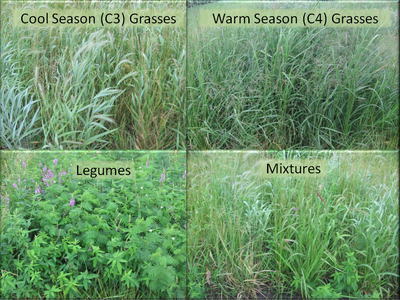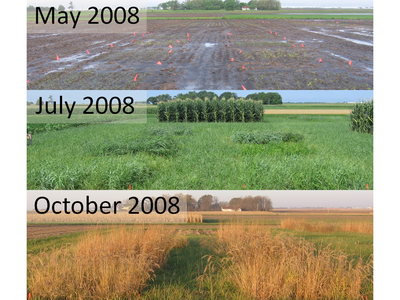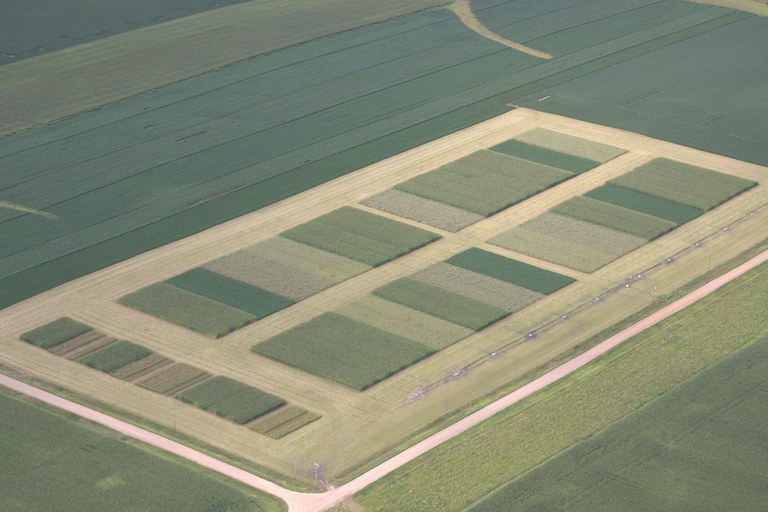Prairies for Bioenergy
- Diversity and Nitrogen (DIVN) Experiment
- Comparison of Biofuel Systems (COBS) Experiment
Diversity and Nitrogen (DIVN) Experiment
The purpose of the DIVN experiment is to examine the relationships between functional diversity and nitrogen fertilization on the productivity and phenology of prairies. The four broadly defined functional groups in prairies are warm-season (C4) grasses, cool-season (C3) grasses, legumes, and forbs. Warm-season grasses are often the dominant grasses in prairies and include big bluestem, switchgrass, and Indiangrass. Warm-season grasses often become dominant later in the growing season - during the hot and dry parts of the summer. Cool-season grasses in prairies begin growing earlier in the growing season than warm-season grasses. Legumes are plants that have mutualistic relationships with nitrogen-fixing bacteria and can add limiting nitrogen to prairie systems. Forbs are broad-leaved plants flowering plants. In the DIVN experiment, we include warm-season grasses, cool-season grasses, and legumes. We examine whether functional diversity can be used to increase resource use complementarity in prairie systems thereby increasing aboveground productivity and whether nitrogen fertilization affects these relationships. A corn treatment is also included in the DIVN experiment in order to compare these prairie systems to our current status quo in biofuel feedstocks.
prairies are warm-season (C4) grasses, cool-season (C3) grasses, legumes, and forbs. Warm-season grasses are often the dominant grasses in prairies and include big bluestem, switchgrass, and Indiangrass. Warm-season grasses often become dominant later in the growing season - during the hot and dry parts of the summer. Cool-season grasses in prairies begin growing earlier in the growing season than warm-season grasses. Legumes are plants that have mutualistic relationships with nitrogen-fixing bacteria and can add limiting nitrogen to prairie systems. Forbs are broad-leaved plants flowering plants. In the DIVN experiment, we include warm-season grasses, cool-season grasses, and legumes. We examine whether functional diversity can be used to increase resource use complementarity in prairie systems thereby increasing aboveground productivity and whether nitrogen fertilization affects these relationships. A corn treatment is also included in the DIVN experiment in order to compare these prairie systems to our current status quo in biofuel feedstocks.

This is a picture of the functional diversity treatments in the DIVN experiment. There are three species plants in each functional group. The three species of cool-season grasses are Canada wildrye, slender wheatgrass, and prairie brome. The three species of warm-season grasses are big bluestem, switchgrass, and Indiangrass. The three species of legumes are Illinois bundleflower, showy ticktrefoil, and round headed bushclover. The mixtures contain all nine species.

The DIVN experiment is located at the Bruner Farm in Boone County, IA. We started the DIVN experiment in the field in May 2008 using prairie seedlings that had been grown in a greenhouse. By October 2008 the prairie plants were nearly full size. This experiment continued through November 2010.
Articles from the DIVN experiment:
- Jarchow, M.E., M. Liebman, V. Rawat, and R.P. Anex (2012) Functional group and fertilization affect the composition and bioenergy yields of prairie plants. Global Change Biology Bioenergy 4:671-679.
- Jarchow, M.E. and M. Liebman (2012) Tradeoffs in biomass and nutrient allocation in prairies and corn managed for bioenergy production. Crop Science 52:1330-1342.
- Jarchow, M.E. and M. Liebman (2012) Nutrient enrichment reduces complementarity and increases priority effects in prairies managed for bioenergy. Biomass and Bioenergy 36:381-389
Comparison of Biofuel Systems (COBS) Experiment
COBS is a large, multi-investigator, long-term, cropping-systems experiment. Click here to go to the COBS experiment website.
My research focus in that experiment is comparing the growth and biomass production of fertilized and unfertilized prairies and continuous corn systems; examining the effects of nitrogen fertilization on prairie diversity, development, and feedstock characteristics; and determining the estimated biofuel yields and net energy balances of all of the cropping systems.

This is an aerial photograph of the COBS experiment taken by Tom Schultz in August 2009. COBS is located at the South Reynoldson Farm in Boone County, IA.
Articles from COBS Experiment:
- Jarchow, M.E. and M. Liebman (2013) Nitrogen fertilization increases diversity and productivity of prairie communities used for bioenergy. Global Change Biology Bioenergy, DOI: 10.1111/j.1757-1707.2012.01186.x.
- Jarchow, M.E., M. Liebman, S. Dhungel, R. Dietzel, D. Sundberg, R.P. Anex, M.L. Thompson, and T. Chua (in revision) Tradeoffs among agronomic, energetic, and environmental performance characteristics of corn and prairie bioenergy cropping systems. Global Change Biology Bioenergy.
You Tube videos featuring the COBS Experiment:
|
|
|---|---|
| Comparison of Biofuel Systems, personnel | Comparison of Biofuel Systems |
| View YouTube Page | View YouTube Page |
